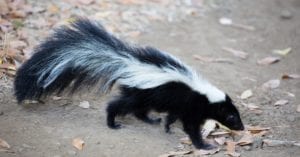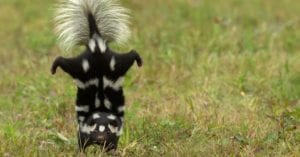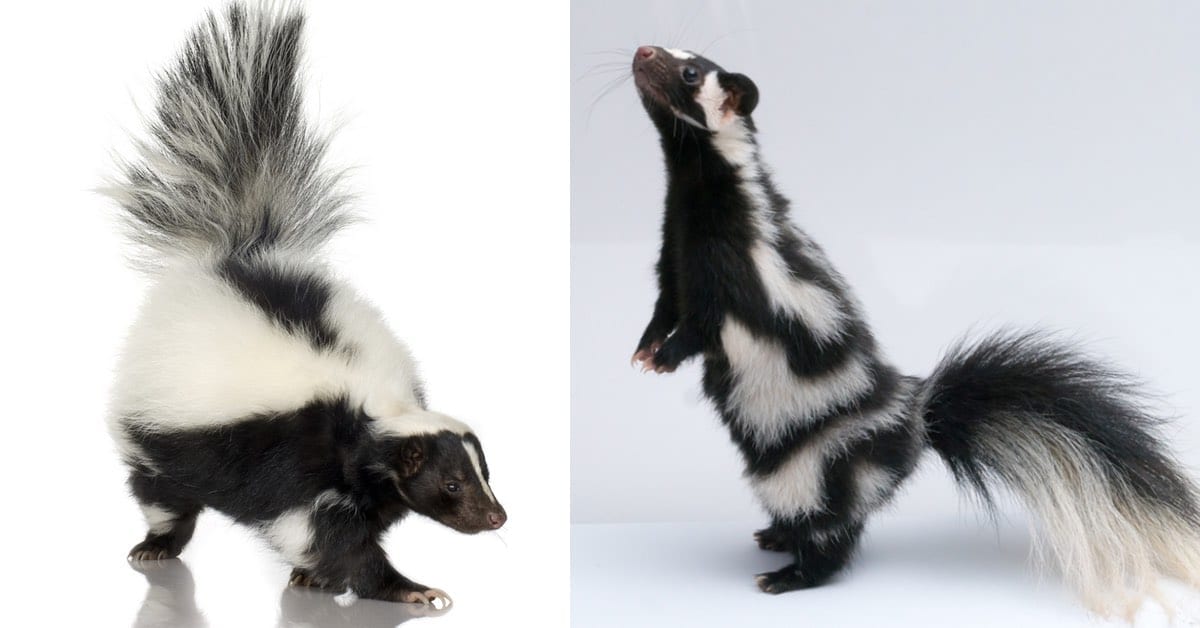Types of Skunks and When They Spray
If you live in New Jersey, there’s a good chance you’ve seen a skunk or two. These small animals live in wooded areas and sometimes find themselves in residential areas. Skunks generally don’t attack people. They can even be beneficial to have on your property. This is mainly because they eat grubs and other pests that can cause harm to your lawn or garden. Skunks even eat mice and rats. Their dens are made in brush piles, tree hollows, log hollows, abandoned animal burrows and underneath porches and foundations. They are known for the putrid, acidic odor they emit when they are afraid or feel they need to defend themselves. Here we list the types of skunks, interesting facts about skunks as well as ways to safely remove these animals from your property.

Striped Skunks
The striped skunk scientific name is Mephitis mephitis. These skunks are commonly found in suburban residential areas. Striped skunks are about the size of a house cat, and are black with pronounced wide white stripes on their backs. These animals also have a thin white stripe on their faces. These are the largest type of skunk and can get as large as 14 pounds.

Spotted Skunks
Spotted skunks are divided into western and eastern varieties. Eastern spotted skunks are distinct because they climb trees. They also have white broken stripes or spots on their backs. The western spotted skunk has wider white stripes on its back and a white-tipped tail. Spotted skunks are tiny, weighing only anywhere from 14 ounces to 2 pounds. These small animals are also known for making noise when they are attacked. Instead of hiding or trying to camouflage themselves, they will hiss or stomp their feet. The skunks will also puff up their fur to appear bigger. If these tactics don’t work, they will raise their tails and spray the predator with their foul-smelling defense mechanism.
Hooded Skunks
A hooded skunk is often mistaken for a striped skunk. However, hooded skunks have softer fur and longer tails. These animals also have tufts of fur around their necks. Some hooded skunks have two white stripes running down their backs, while others have one wide white stripe and a white tail.
When Skunks Spray
Skunks are not naturally aggressive animals. However, they will defend themselves if they feel like they’re in danger. The animals have glands located under their tails that produce skunk musk. The chemical makeup and odor of the musk vary according to the species of the skunk. However, each version of the skunk spray contains thiols. These are compounds that give the musk its terrible odor.
When a skunk sprays to ward off an attack, the musk can travel for about 10 feet. However, the smell can be detected from much further away. Hooded skunks and striped skunks are especially accurate with their aim. This usually means an attacker will back off shortly after being sprayed. Skunk musk is harmless for the most part, but the smell can make some people nauseous. If you’re sprayed by a skunk, don’t get any of the musk in your eyes, since it will impair your vision temporarily. Skunk musk odor also lingers for a few days, even after washing several times to get rid of the smell.
Contact NJ Pest Control for practical and effective solutions when it comes to skunk removal. Our professionals will evaluate your property to let you know which areas are most attractive to skunks. We also have a number of environmentally friendly methods to rid your property of skunks. Give us a call, email us or use our contact form to today to set up your appointment.

